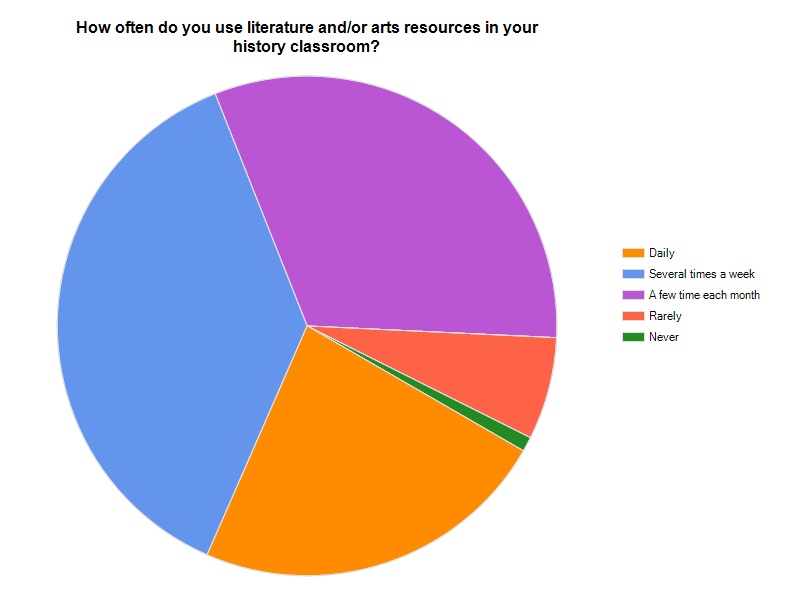What are History Teachers Looking for Online?
Among the projects of the education team at ASHP/CML is the development of an online database of history resources for educators.  Although the launch of the database is several months off, we recently conducted a survey of educators to find out more about how they use the web to find resources for their classrooms.  We were curious to know about what kinds of web-based technology teachers had access to, what sorts of materials they look for online, and what they generally do with what they find online.  We collected 228 responses from 38 states and the District of Columbia.  (By the way, thank  you to those of you on our mailing lists who took the time to complete the survey or to pass it along to colleagues.)
Our educators came from a variety of educational settings: traditional middle school and high school US history teachers, elementary (and even one pre-K!) teachers, college and university educators, administrators, museum educators, and academic support staff within school districts or buildings. Â About a quarter of our teachers self-identified as teachers of special education and/or ESL/ELL (English-as-a-Second Language/English-Language-Learners). Â Most of our respondents teach in urban or suburban public schools.
Broadly speaking, our first few questions asked teachers what they look for on the web. Â The vast majority are looking for primary sources and background information (67% and 65% respectively). Â Access to LCD projectors for displaying presentations, images, or video is almost universal (only 4% reported not having access), and there were no glaring disparities among teachers who teach at urban, suburban, or rural schools, or those who teach in public versus private schools. Â We found that while many teachers do not have access to Smartboards (39%), those who do have Smartboards use them at least once a week (31%). Â We were pleasantly surprised to learn that many educators look for streaming audio and video materials, and that most teachers have some sort of access for presenting such materials to their students. Â Perhaps not surprisingly, ESL/ELL and special education teachers were most likely to use streaming audio and video, suggesting that they try to deliver content in different media to reach different types of learners.
 We were gratified to learn that a whopping 61% of our educators use arts and/or literature resources in their history classrooms daily or at least once a week! Â Rates among ESL and elementary teachers were even higher (71% and 76%). Â Both our Making Connections seminars and the PUSH forum focus on the importance of using interdisciplinary resources and methods to understand and teach the past, and we will continue to feature our arts and literature resources in our workshops, online forums, and in the forthcoming resource database.
We were gratified to learn that a whopping 61% of our educators use arts and/or literature resources in their history classrooms daily or at least once a week! Â Rates among ESL and elementary teachers were even higher (71% and 76%). Â Both our Making Connections seminars and the PUSH forum focus on the importance of using interdisciplinary resources and methods to understand and teach the past, and we will continue to feature our arts and literature resources in our workshops, online forums, and in the forthcoming resource database.
Here are a few of our other findings:
- How teachers search for history materials differs by the level they teach. Â High school teachers prefer to search by historical era (Antebellum America, The Progressive Era), middle school teachers tend to search by keyword (Dorothea Dix, Boston Massacre), and elementary teachers primarily search by theme (women, African Americans)
- Middle school teachers are most likely to shorten a document; to me this indicates that they are committed to using primary sources, but have difficulty finding items that work for their students’ reading levels and attention spans.
- Educators were largely uninterested in social networking features such as rating resources, leaving comments, or viewing how others have modified resources. Â Special education teachers were somewhat more interested in sharing how they adapt materials and seeing how others use a resource, which makes sense given that many history education resources probably do not work “as is” in their classrooms.
- Teachers prefer materials that they can modify to meet their needs. Â This finding backs up what teachers told us in a focus group: they tend to skim lesson plans and activity instructions for ideas rather than use them wholesale, they like to add their own questions to primary sources.
- Teachers did not report much use of games with their students. Â I’d like to know more. Â Do teachers not see the value in games? Â Do they regard games as play, rather than learning? Â Or are they simply unable to find pedagogically and academically sound games to help their students learn history?
Gosh, I could go on about survey data forever (just ask my colleagues)… Â If you want to know more or if this data could help you or your organization better plan for the needs of history educators, don’t hesitate to contact me.
Last 5 posts by Leah Nahmias
- Teaching "What This Cruel War Was Over" - March 28th, 2011
- State of Siege and Public Memory at Ole Miss - March 25th, 2011


